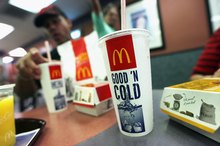What does fact checked mean?
At Healthfully, we strive to deliver objective content that is accurate and up-to-date. Our team periodically reviews articles in order to ensure content quality. The sources cited below consist of evidence from peer-reviewed journals, prominent medical organizations, academic associations, and government data.
The information contained on this site is for informational purposes only, and should not be used as a substitute for the advice of a professional health care provider. Please check with the appropriate physician regarding health questions and concerns. Although we strive to deliver accurate and up-to-date information, no guarantee to that effect is made.
Congestive Heart Failure & Caffeine
Congestive heart failure, or CHF, is a condition in which the heart cannot pump enough blood to body organs. This causes a build up of fluid in the lungs and other organs. CHF may be caused by chronic hypertension, coronary artery disease, heart attack, heart valve disease, congenital heart defects and heart muscle disease. Caffeine can aggravate CHF and other heart problems.
Caffeine and Congestive Heart Failure
Doctors advise patients with CHF to avoid drinks and medications that contain caffeine, according to Ohio State University Medical Center. Caffeine is a stimulant and causes increased or irregular heart rate in patients with CHF. Caffeine constricts blood vessels and forces the heart to contract with a stronger rapid force leading to a rapid and irregular heartbeat.
Sources of Caffeine
Rapid Heartbeats After Diet Pills
Learn More
Caffeine is a bitter substance that is produced naturally from plants. It has a stimulant effect on the central nervous system and also speeds metabolism. Caffeine increases energy and alertness.
Side Effects of Caffeine
Patients who stop taking caffeine may also experience withdrawal symptoms.
Symptoms of Congestive Heart Failure
Can Excess Caffeine Cause Rashes?
Learn More
Medical treatments can help patients manage symptoms.
Related Articles
References
- American Heart Association: Congestive
- MayoClinic.com: Caffeine
- Meredith SE, Juliano LM, Hughes JR, Griffiths RR. Caffeine Use Disorder: A Comprehensive Review and Research Agenda. J Caffeine Res. 2013;3(3):114-130. doi:10.1089/jcr.2013.0016
- Richards G, Smith AP. A Review of Energy Drinks and Mental Health, with a Focus on Stress, Anxiety, and Depression. J Caffeine Res. 2016;6(2):49-63. doi:10.1089/jcr.2015.0033
- Brunyé TT, Mahoney CR, Rapp DN, Ditman T, Taylor HA. Caffeine enhances real-world language processing: evidence from a proofreading task. J Exp Psychol Appl. 2012;18(1):95-108. doi:10.1037/a0025851
- Koppelstaetter F, Poeppel TD, Siedentopf CM, et al. Caffeine and cognition in functional magnetic resonance imaging. J Alzheimers Dis. 2010;20 Suppl 1:S71-84. doi:10.3233/JAD-2010-1417
- Harrell PT, Juliano LM. Caffeine expectancies influence the subjective and behavioral effects of caffeine. Psychopharmacology (Berl). 2009;207(2):335-42. doi:10.1007/s00213-009-1658-5
- Lucas M, O'reilly EJ, Pan A, et al. Coffee, caffeine, and risk of completed suicide: results from three prospective cohorts of American adults. World J Biol Psychiatry. 2014;15(5):377-86. doi:10.3109/15622975.2013.795243
- Abdel-Hady H, Nasef N, Shabaan AE, Nour I. Caffeine therapy in preterm infants. World J Clin Pediatr. 2015;4(4):81-93. doi:10.5409/wjcp.v4.i4.81
- American Psychiatric Association. Diagnostic and Statistical Manual of Mental Disorders. 5th edition. Washington DC; 2013.
- Turnbull D, Rodricks JV, Mariano GF, Chowdhury F. Caffeine and cardiovascular health. Regul Toxicol Pharmacol. 2017;89:165-185. doi:10.1016/j.yrtph.2017.07.025
- Centers for Disease Control and Prevention. Alcohol and Caffeine. Updated October 23, 2018.
- Alsunni AA. Energy Drink Consumption: Beneficial and Adverse Health Effects. Int J Health Sci (Qassim). 2015;9(4):468-474.
- Lyngsø J, Ramlau-Hansen CH, Bay B, Ingerslev HJ, Hulman A, Kesmodel US. Association between coffee or caffeine consumption and fecundity and fertility: a systematic review and dose-response meta-analysis. Clin Epidemiol. 2017;9:699-719. doi:10.2147/CLEP.S146496
- U.S. Food and Drug Administration. Pure and Highly Concentrated Caffeine. Updated September 21, 2018.
- National Institute on Drug Abuse. Drugs, Brains, and Behavior: The Science of Addiction. Updated July 2018.
Writer Bio
Destiny Simmons has worked as a professional health writer since 2005. She specializes in health and nutrition articles. Her work has appeared in various health Web sites. Destiny holds a Bachelors of Science in nursing from Boston University and a Master of Public Health Nutrition from Tufts University.









